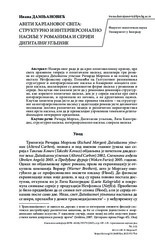Приказ основних података о документу
Авети Харлановог света: структурално и имперсонално насиље у романима и серији Дигитални угљеник
Spectres of The Harlan’s World: Structural and Interpersonal Violence in Novels and Netflix Show Altered Carbon
| dc.creator | Damnjanović, Ivana | |
| dc.date.accessioned | 2024-02-14T11:36:48Z | |
| dc.date.available | 2024-02-14T11:36:48Z | |
| dc.date.issued | 2023 | |
| dc.identifier.issn | 0350-6428 | |
| dc.identifier.uri | http://rfpn.fpn.bg.ac.rs/handle/123456789/1147 | |
| dc.description.abstract | Намера овог рада је да кроз политиколошку призму, пре свега применом теорија о политичком насиљу, анализира три романа из серијала Дигитални угљеник Ричарда Моргана и на основу њих насталу Нетфликсову серију. Полазећи од Галтунговог разликовања структурног и интерперсоналног насиља и Камариног концепта спирале насиља, анализиране су доминантне форме насиља у романима и серији. Закључак ове анализе јесте да у романима доминира структурно, као изразито политичко насиље, док је у серији насиље пре свега интерперсонално, и произлази из личних, а не друштвених односа. Кључна хипотеза рада јесте да је ова промена тежишта – од структурног ка интерперсоналном насиљу у адаптацији романа јесте делимично последица захтева различитих медија и различитих карактеристика ових врста насиља, али да је превасходно узрокована темељном деполитизацијом литерарног предлошка. | sr |
| dc.description.abstract | Both Richard Morgan’s Altered Carbon (alternatively Takeshi Kovacs) series and its Netflix adaptation have already attracted some academic attention, but although their political aspects are acknowledged by some scholars, this is usually not what the main focus is on. The present paper is an attempt to fill this gap in literature and analyze the novels as well as the Netflix show from the perspective of political science, specifically using theories of political violence. After a short review of literature on adaptations, especially regarding the emerging role of the showrunners as creative authors in their own right, the theoretical framework for the discussion of violence in both novels and the show is presented. It relies primarily on the notion of structural violence as social injustice, first developed by Johan Galtung, and combines it with the idea of the spiral of violence as conceptualized by Helder Camara. A key feature of structural violence is that, as the terms suggests, it stems from the social structure, and manifests as social injustice, with no identifiable perpetrator of violence. This social injustice, Camara claims in his work, is the first step of the spiral of violence, since it begets rage, either of those suffering, or of the youth that sympathizes with them, erupting in violent protest against the authorities. Authorities then respond with the use of force, thus inflicting new in- justices, and the spiral continues. This is exactly what is found in the Altered Carbon novels – the omnipresent poverty and lack of opportunities draws the father of the protagonist, the typical antihero Takeshi Kovacs, to abusive behavior. The young Takeshi then responds in kind, first by joining a street gang, and later em- barking on a military career. It is also why the Harlans World is the birthplace of a resistance philosophy and movement, led by Quellkrist Falconer. The Netflix show, however, replaces all external motivations for violent behavior of Takeshi Kovacs (and other characters) with those that are strictly personal: love, betrayal, revenge. This effectively erases structural violence present in the novel substituting it with interpersonal, non-political violence. There are three possible reasons for this: the very features of structural violence that make it harder to show through the visual medium (as opposed to the intrinsic action and drama of interpersonal violence); the process of adaptation which favors psychological over sociological narratives, focusing on internal instead on external incentives and motivations of the characters; and, finally, a creative decision made by the showrunner and the production company. Since the first two reasons can be mitigated, evaded, or overcome by the creative vision, the final conclusion is that this shift from structural to interpersonal violence is the consequence of the de-politization of the narrative, consciously made by the creators of the Netflix show. | sr |
| dc.language.iso | sr | sr |
| dc.publisher | Београд : Институт за књижевност и уметност | sr |
| dc.relation | Рад је подржан средствима Министарства науке, технолошког развоја и иновација Републике Србије на основу Уговора о реализацији и финансирању научно-истраживачког рада НИО у 2023. години, број: 451-03-47/2023-01 од 17.01.2023. године. | sr |
| dc.rights | openAccess | sr |
| dc.rights.uri | https://creativecommons.org/licenses/by-nc-nd/4.0/ | |
| dc.source | Књижевна историја | sr |
| dc.subject | Ričard Morgan | sr |
| dc.subject | digitalni ugljenik | sr |
| dc.subject | Lita Кalogridis | sr |
| dc.subject | strukturno nasilje | sr |
| dc.subject | interpersonalno nasilje | sr |
| dc.subject | spirala nasilja | sr |
| dc.subject | Richard Morgan | sr |
| dc.subject | Altered Carbon | sr |
| dc.subject | Takeshi Kovacs | sr |
| dc.subject | Laeta Kalogridis | sr |
| dc.subject | structural violence | sr |
| dc.subject | interpersonal violence | sr |
| dc.subject | spiral of violence | sr |
| dc.title | Авети Харлановог света: структурално и имперсонално насиље у романима и серији Дигитални угљеник | sr |
| dc.title | Spectres of The Harlan’s World: Structural and Interpersonal Violence in Novels and Netflix Show Altered Carbon | sr |
| dc.type | article | sr |
| dc.rights.license | BY-NC-ND | sr |
| dc.citation.epage | 125 | |
| dc.citation.issue | 179 | |
| dc.citation.rank | M23 | |
| dc.citation.spage | 105 | |
| dc.citation.volume | 55 | |
| dc.identifier.doi | 10.18485/kis.2023.55.179.6 | |
| dc.identifier.fulltext | http://rfpn.fpn.bg.ac.rs/bitstream/id/3309/fulltext.pdf | |
| dc.type.version | publishedVersion | sr |

